The Effect of Munsell Neutral Value Scale on the Color of Yellow Jadeite and Comparison between AP and K-Means Clustering Color Grading Schemes
Abstract
:1. Introduction
2. Materials and Methods
2.1. Samples
2.2. UV-VIS Spectrum
2.3. Backgrounds
2.4. Color Quantification
2.5. Color Space
2.6. Color Difference Formula
2.7. Clustering Methods
3. Results
3.1. UV-Vis Spectra
3.2. The Effect of 19 Munsell Neutral Value Scales on Yellow Jadeite
3.3. Effect of Transparency of the Yellow Jadeite on Different Backgrounds
3.4. The Color Grading Result of Yellow Jadeite on the N9.5 Background
4. Discussion
4.1. The Reason for the Variations in the of the Yellow Jadeite on Different Backgrounds
4.2. The Comparison between AP and K-Means Cluster Methods
5. Conclusions
Supplementary Materials
Author Contributions
Funding
Data Availability Statement
Acknowledgments
Conflicts of Interest
References
- Hughes, R.; Galibert, O.; Bosshart, G.; Ward, F.; Oo, T.; Smith, M.; Tay, T.; Harlow, G. Burmese Jade: The Inscrutable Gem. Gems Gemol. 2000, 36, 2–25. [Google Scholar] [CrossRef] [Green Version]
- Harlow, G.; Sorensen, S. Jadeitite from Guatemala: Distinctions among multiple occurrences. Geol. Acta 2011, 9, 363–387. [Google Scholar] [CrossRef]
- Shi, G.; Harlow, G.; Wang, J.; Wang, J.; Enoch, N.G.; Wang, X.; Cao, S.; Enyuancui, W. Mineralogy of jadeitite and related rocks from Myanmar: A review with new data. Eur. J. Mineral. 2012, 24, 345–370. [Google Scholar] [CrossRef]
- Yui, T.-F.; Maki, K.; Usuki, T.; Lan, C.-Y.; Martens, U.; Wu, C.-M.; Wu, T.-W.; Liou, J.G. Genesis of Guatemala jadeitite and related fluid characteristics: Insight from zircon. Chem. Geol. 2010, 270, 45–55. [Google Scholar] [CrossRef]
- Tsujimori, T.; Harlow, G. Petrogenetic relationships between jadeitite and associated high-pressure and low-temperature metamorphic rocks in worldwide jadeitite localities: A review. Eur. J. Mineral. 2012, 24, 371–390. [Google Scholar] [CrossRef] [Green Version]
- Wang, H.; Ying, G.; Zhang, Y. Difference Analysis of Different Standard Illuminants on Yellow-Green to Green Jadeite-Jade. Key. Eng. Mater. 2011, 492, 374–378. [Google Scholar] [CrossRef]
- Yan, W.W.; Yuan, X.Q. Study on the secondary colour of myanmar jade by first order derivative UV spectrophotometry. Kuangwu Yanshi J. Mineral. Petrol. 2012, 32, 1–5. [Google Scholar] [CrossRef]
- Pan, X.; Guo, Y.; Liu, Z.Y.; Zhang, Z.K.; Shi, Y.X. Impact of different standard lighting sources on red jadeite and color quality grading. Earth Sci. Res. J. 2019, 23, 371–378. [Google Scholar] [CrossRef] [Green Version]
- Xiao, Y.; Ying, G.; Chen, D. The Influences of Lightness Variation of the Non-Color Background on the Color of the Blood Amber. Key. Eng. Mater. 2014, 633, 524–535. [Google Scholar] [CrossRef]
- Ma, L.; Ying, G.; Tang, W. The Influence of Variety Lightness of Neutral Background on Peridot’s Color Appearance. Key. Eng. Mater. 2013, 591, 281–284. [Google Scholar] [CrossRef]
- Tang, J.; Guo, Y.; Xu, C. Light Pollution Effects of Illuminance on Yellowish Green Forsterite Color under CIE Standard Light Source D-65. Ekoloji 2018, 27, 1181–1190. [Google Scholar]
- Liou, J.-J. A Novel Color Recognition Model for Improvement on Color Differences in Products via Grey Relational Grade. Axioms 2021, 10, 266. [Google Scholar] [CrossRef]
- Ying, G.; Wang, H.; Xiang, L.; Dong, S. Metamerism Appreciation of Jadeite-Jade Green under the Standard Light Sources D 65, A and CWF. Acta Geol. Sin. Engl. Ed. 2016, 90, 2097–2103. [Google Scholar] [CrossRef]
- Tang, J.; Guo, Y.; Xu, C. Color effect of light sources on peridot based on CIE1976 L*a*b* color system and round RGB diagram system. Color Res. Appl. 2019, 44, 932–940. [Google Scholar] [CrossRef]
- Mangkuto, R.A.; Enge, A.; Munir, F.; Soelami, F.N. The effects of illuminance, colour temperature, and colour rendering of various existing light-emitting diode lamps on subjective preference and performance in Indonesia. J. Build. Eng. 2018, 19, 334–341. [Google Scholar] [CrossRef]
- Tantanatewin, W.; Inkarojrit, V. Effects of color and lighting on retail impression and identity. J. Environ. Psychol. 2016, 46. [Google Scholar] [CrossRef]
- Zhao, Z.; Ying, G. Colour Quality Evaluation of Bluish-Green Serpentinite Based on the CIECAM16 Model. Minerals 2021, 12, 38. [Google Scholar] [CrossRef]
- Xu, C.; Wu, C.-F.; Xu, D.-D.; Lai, Y.-S. Have the Display Illumination Design Misled Customers on Color Perception? A Study on Differences of Color Caused by LED Lighting on Leather Products; Springer: Berlin/Heidelberg, Germany, 2020; pp. 346–353. [Google Scholar]
- Munsell, A.; Sloan, L.; Godlove, I. Neutral Value Scales. I. Munsell Neutral Value Scale. JOSA 1933, 23, 394–402. [Google Scholar] [CrossRef]
- Liu, Y.; Shigley, J.E.; Moses, T.M.; King, J.M. Color Grading of Colored Diamonds in the GIA Gem Trade Laboratory. Gems Gemol. 1994, 30, 220–242. [Google Scholar] [CrossRef]
- King, J.; Moses, T.; Shigley, J.; Welbourn, C.; Lawson, S.; Cooper, M. Characterizing Natural-Color Type IIb Blue Diamonds. Gems Gemol. 1998, 34, 246–268. [Google Scholar] [CrossRef]
- Eaton-Magaña, S.; Ardon, T.; Smit, K.; Breeding, C.; Shigley, J. Natural-Color Pink, Purple, Red, and Brown Diamonds: Band of Many Colors. Gems Gemol. 2019, 54, 352–377. [Google Scholar] [CrossRef]
- King, J.; Shigley, J.; Gelb, T.; Guhin, S.; Hall, M.; Wang, W. Characterization and Grading of Natural-Color Yellow Diamonds. Gems Gemol. 2005, 41, 88–115. [Google Scholar] [CrossRef]
- King, J.; Geurts, R.; Gilbertson, A.; Shigley, J. Color Grading “D-to-Z” Diamonds at the GIA Laboratory. Gems Gemol. 2008, 44, 296–321. [Google Scholar] [CrossRef]
- McLaren, K. The Development of the CIE 1976 (L*a*b*) Uniform Colour-Space and Colour-Difference Formula. J. Soc. Dye. Colour 2008, 92, 338–341. [Google Scholar] [CrossRef]
- Han, J.; Ying, G.; Liu, S. Environmental Issues on Color Quality Evaluation of Blue Sapphire based on Gemdialogue TM Color Comparison Charts. Ekoloji 2018, 27, 1365–1376. [Google Scholar]
- Guo, Y.; Zong, X.; Qi, M. Feasibility study on quality evaluation of Jadeite-jade color green based on GemDialogue color chip. Multimed. Tools Appl. 2019, 78, 841–856. [Google Scholar] [CrossRef]
- Ying, G.; Zhang, J.; Mo, T. Contribution of Green Jadeite-Jade’s Chroma Difference Based on CIE 1976 L*a*b* Uniform Color Space. Adv. Mater. Res. 2010, 177, 620–623. [Google Scholar] [CrossRef]
- Zhang, S.F.; Guo, Y. Measurement of Gem Colour Using a Computer Vision System: A Case Study with Jadeite-Jade. Minerals 2021, 11, 791. [Google Scholar] [CrossRef]
- Ying, G. Quality evaluation of tourmaline red based on uniform color space. Clust. Comput. 2017, 20. [Google Scholar] [CrossRef]
- Liu, Y. Colour hue change of a gem tourmaline from the Umba Valley, Tanzania. J. Gemmol. 1999, 26, 386–396. [Google Scholar] [CrossRef]
- Liu, Y.; Shigley, J.; Fritsch, E.; Hemphill, S. The “alexandrite effect” in gemstones. Color Res. Appl. 1994, 19, 186–191. [Google Scholar] [CrossRef]
- Cheng, R.P.; Guo, Y. Study on the effect of heat treatment on amethyst color and the cause of coloration. Sci. Rep. 2020, 10. [Google Scholar] [CrossRef] [PubMed]
- Wang, X.D.; Guo, Y. The impact of trace metal cations and absorbed water on colour transition of turquoise. R. Soc. Open Sci. 2021, 8, 201110. [Google Scholar] [CrossRef] [PubMed]
- Jiang, Y.S.; Guo, Y. Genesis and influencing factors of the colour of chrysoprase. Sci. Rep. 2021, 11. [Google Scholar] [CrossRef]
- Qiu, Y.; Guo, Y. Explaining Colour Change in Pyrope-Spessartine Garnets. Minerals 2021, 11, 865. [Google Scholar] [CrossRef]
- Wang, H.; Guan, Q.; Liu, Y.; Guo, Y. Effects of Transition Metal Ions on the Colour of Blue-Green Beryl. Minerals 2022, 12, 86. [Google Scholar] [CrossRef]
- Tang, J.; Guo, Y.; Xu, C. Metameric effects on peridot by changing background color. J. Opt. Soc. Am. A-Opt. Image Sci. Vis. 2019, 36, 2030–2039. [Google Scholar] [CrossRef]
- Jiang, Y.S.; Guo, Y.; Zhou, Y.F.; Li, X.; Liu, S.M. The Effects of Munsell Neutral Grey Backgrounds on the Colour of Chrysoprase and the Application of AP Clustering to Chrysoprase Colour Grading. Minerals 2021, 11, 1092. [Google Scholar] [CrossRef]
- Han, J.; Kamber, M.; Pei, J. Data Mining: Concepts and Techniques third edition. Morgan Kaufmann Ser. Data Manag. Syst 2011, 5, 83–124. [Google Scholar]
- Pan, X.; Guo, Y.; Liu, Z.; Zhang, Z.; Shi, Y. Application of cluster analysis and discriminant analysis in quality grading of jadeite red. J. Phys. Conf. Ser. 2019, 1324, 012101. [Google Scholar] [CrossRef] [Green Version]
- Frey, B.; Dueck, D. Clustering by Passing Messages Between Data Points. Science 2007, 315, 972–976. [Google Scholar] [CrossRef] [PubMed] [Green Version]
- Pecho, O.; Ghinea, R.I.; Alessandretti, R.; Gómez, M.d.M.P.; della Bona, A. Visual and instrumental shade matching using CIELAB and CIEDE2000 color difference formulas. Dent. Mater. 2015, 32, 82–92. [Google Scholar] [CrossRef] [PubMed]
- Liu, F.; Ying, G.; Lv, S.; Chen, G. Application of the Entropy Method and Color Difference Formula to the Evaluation of Round Brilliant Cut Diamond Scintillation. Mathematics 2020, 8, 1489. [Google Scholar] [CrossRef]
- Lu, Z.; He, X.; Lin, C.; Jin, X.; Pan, Y. Identification of Beihong Agate and Nanhong Agate from China Based on Chromaticity and Raman Spectra. Guang Pu Xue Yu Guang Pu Fen Xi Guang Pu 2019, 39, 2153–2159. [Google Scholar] [CrossRef]
- Sherman, D.; Waite, T. Electronic Spectra of Fe3+ Oxides and Oxide Hydroxides in the Near IR to Near UV. Am. Mineral. AMER MINERAL 1985, 70, 1262–1269. [Google Scholar]
- Yuan, X.; Qi, L.; Du, G.; Chen, X. UV-VIS-NIR Spectrum of Jadeite Jade from Burma. J. Gems Gemmol. 2003, 11–16. [Google Scholar] [CrossRef]
- Liu, M.; Zhang, Y.; Wu, C.; Xiong, S.; Zhou, C. Chitosan/halloysite nanotubes bionanocomposites: Structure, mechanical properties and biocompatibility. Int. J. Biol. Macromol. 2012, 51, 566–575. [Google Scholar] [CrossRef]
- Chang, C.-W.; Hon, M.-H.; Leu, I.-C. The transmittance and sheet resistance of chemically and heat reduced graphene oxide film. Opt. Quantum Electron. 2018, 51, 1–7. [Google Scholar] [CrossRef]
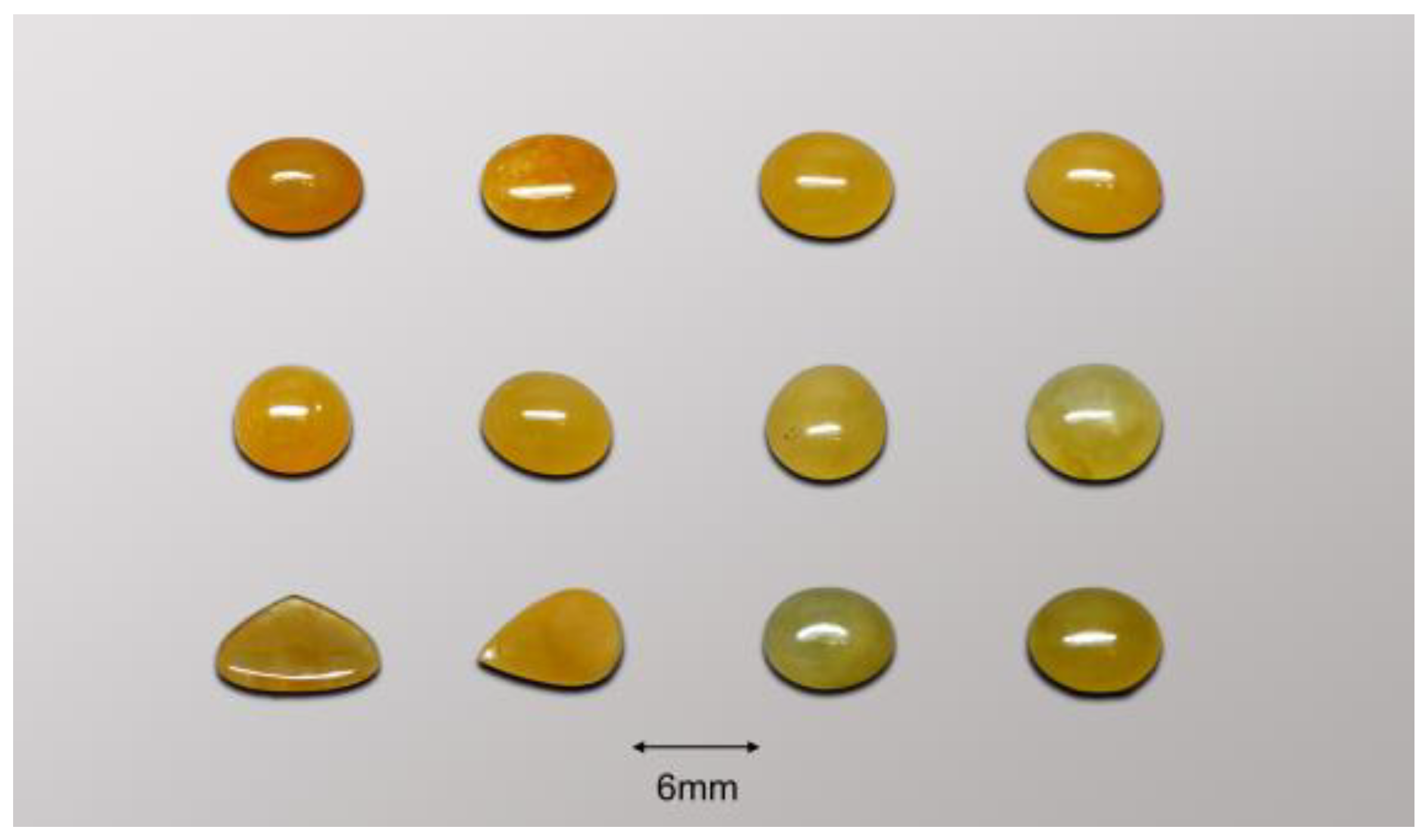
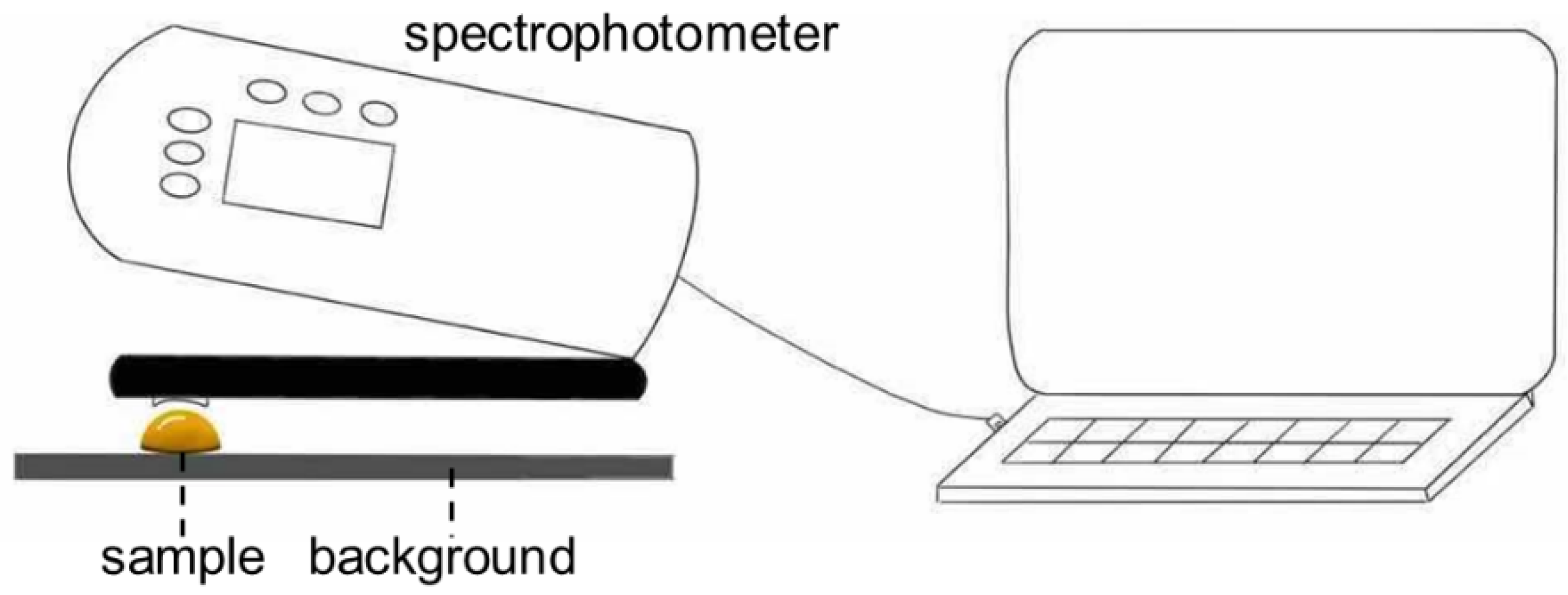
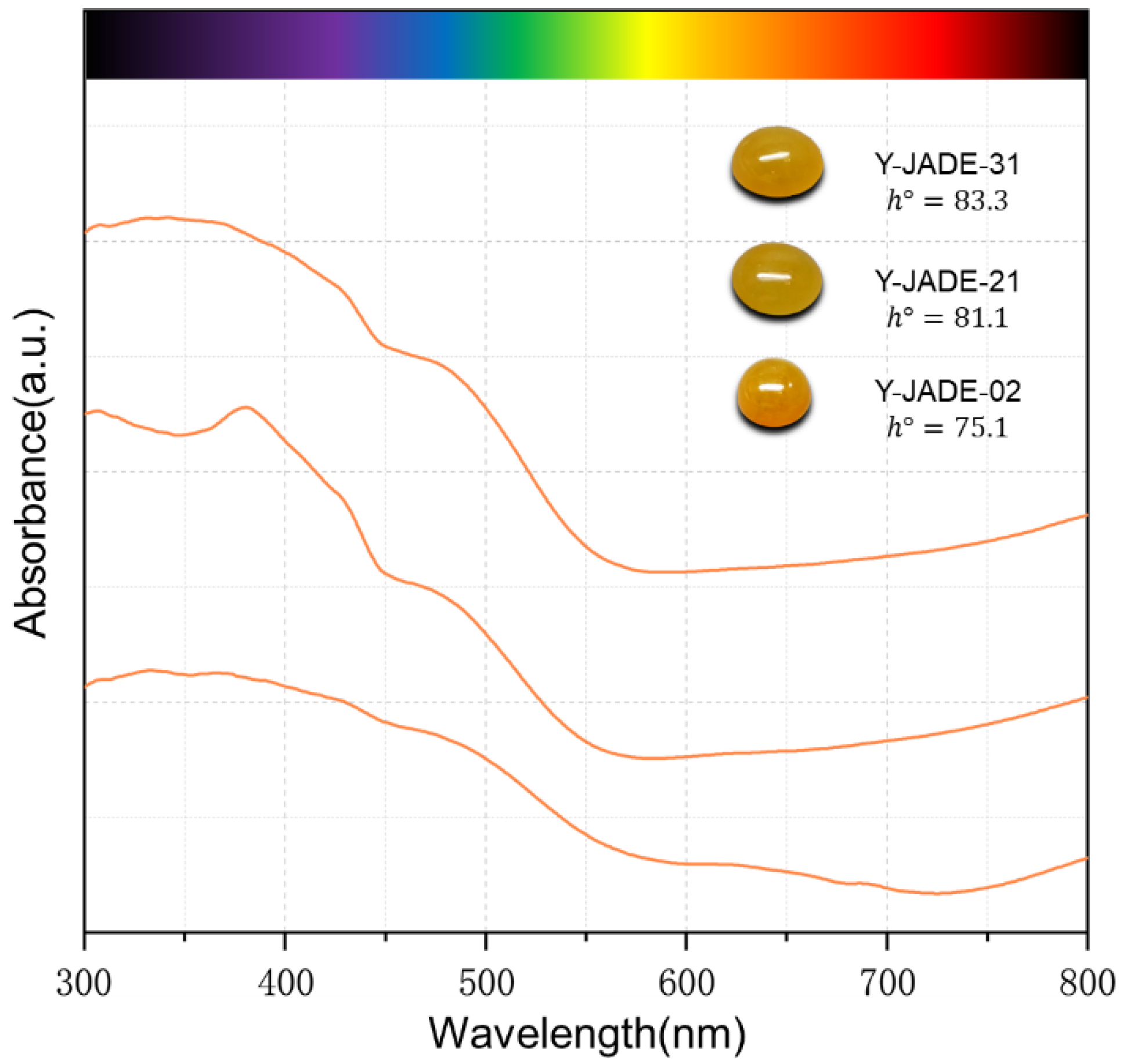

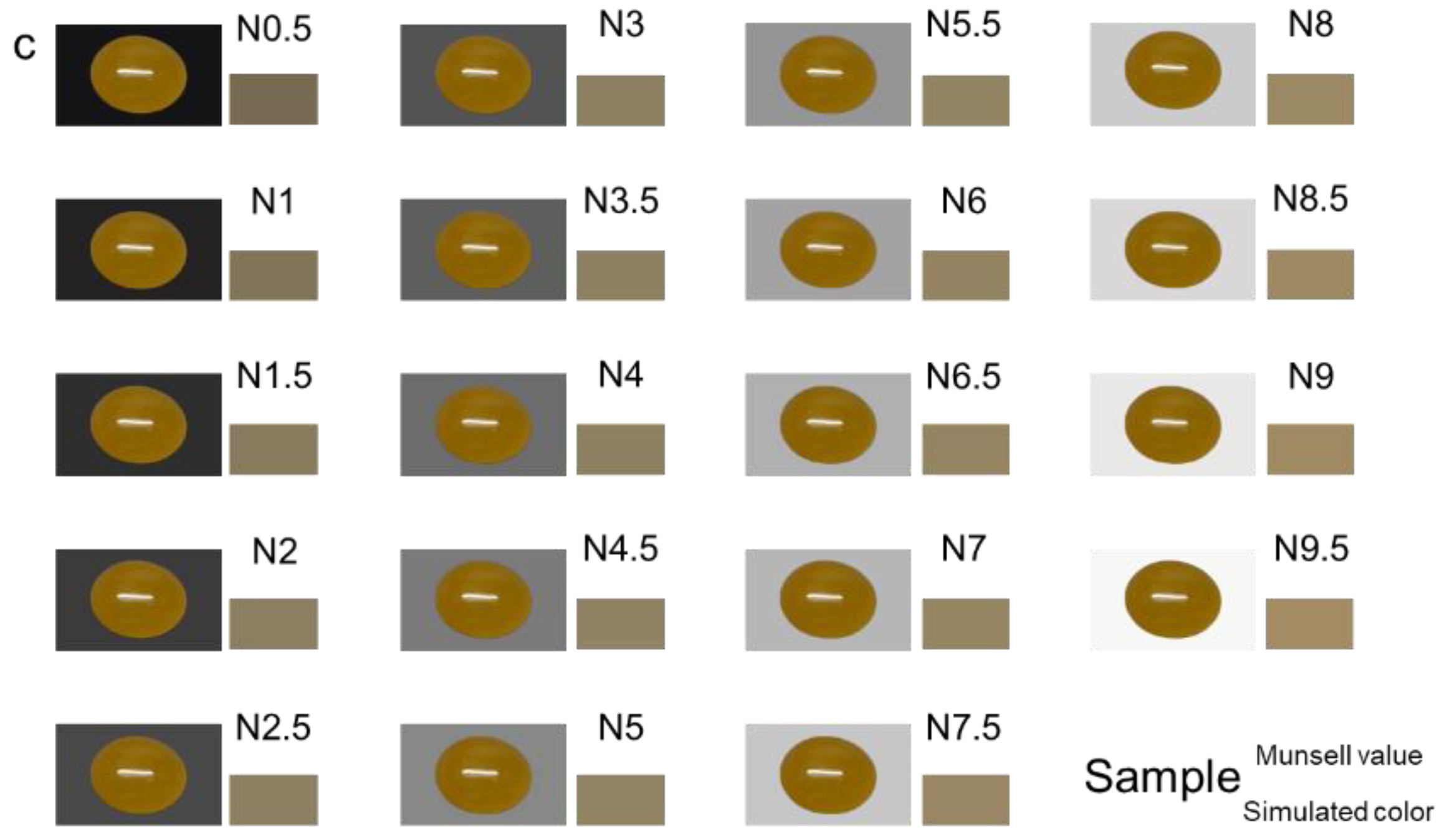
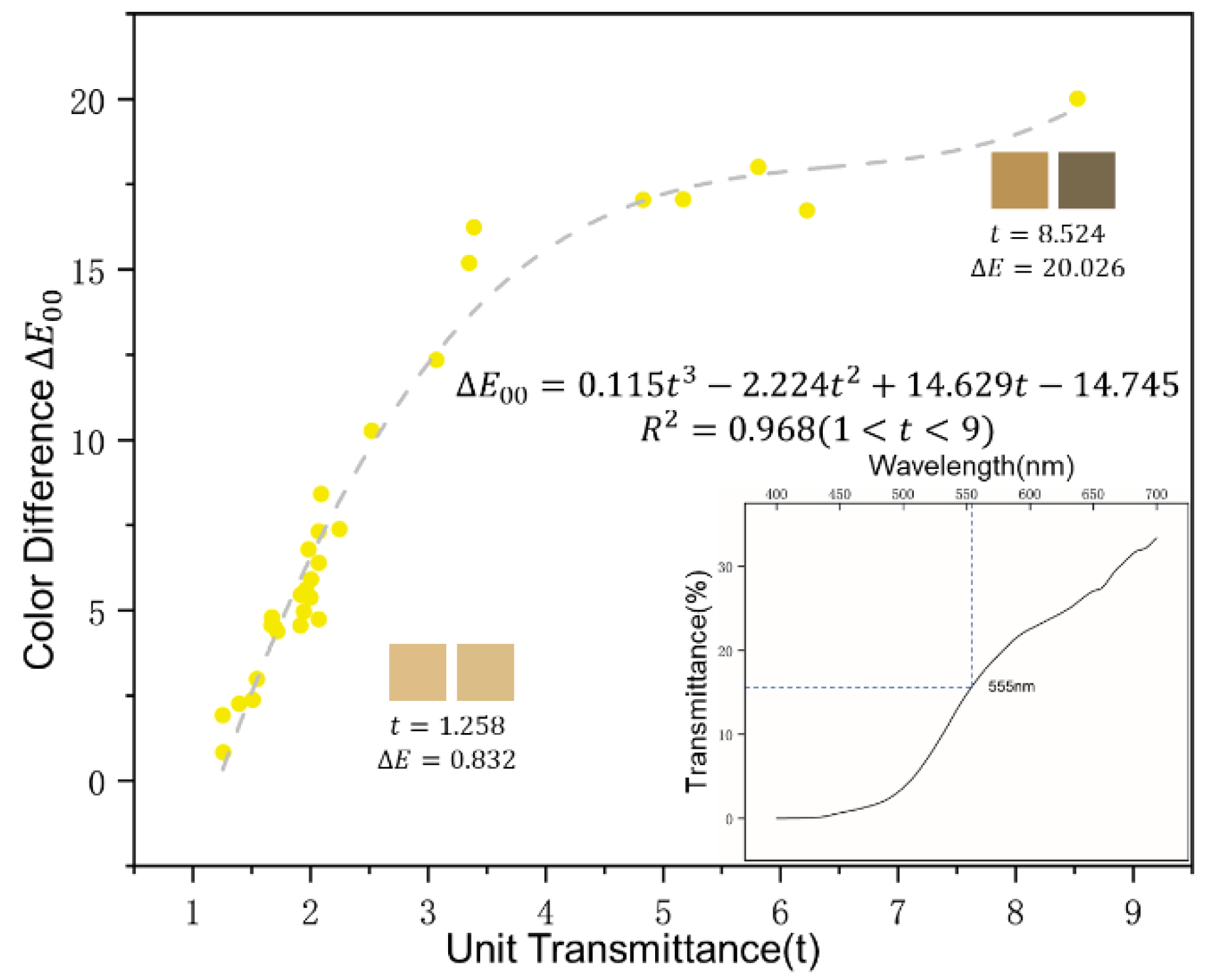
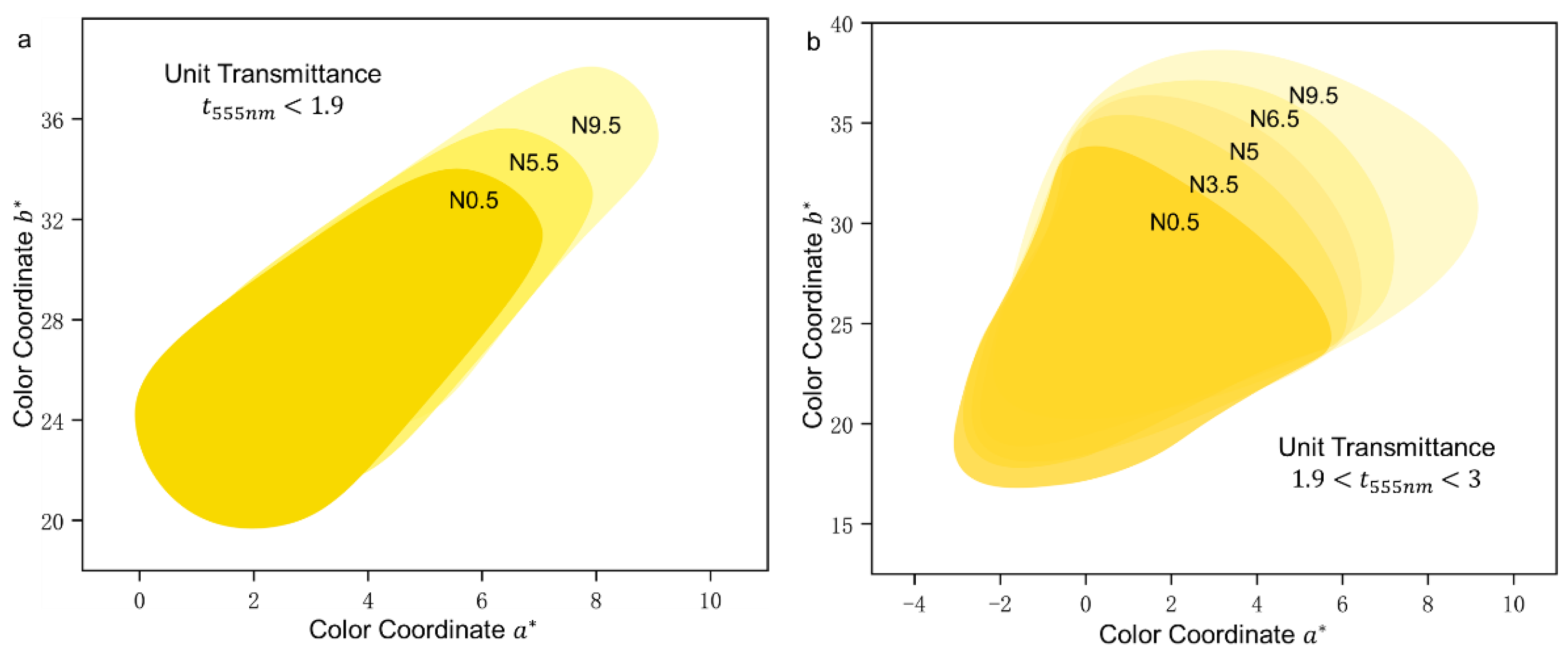


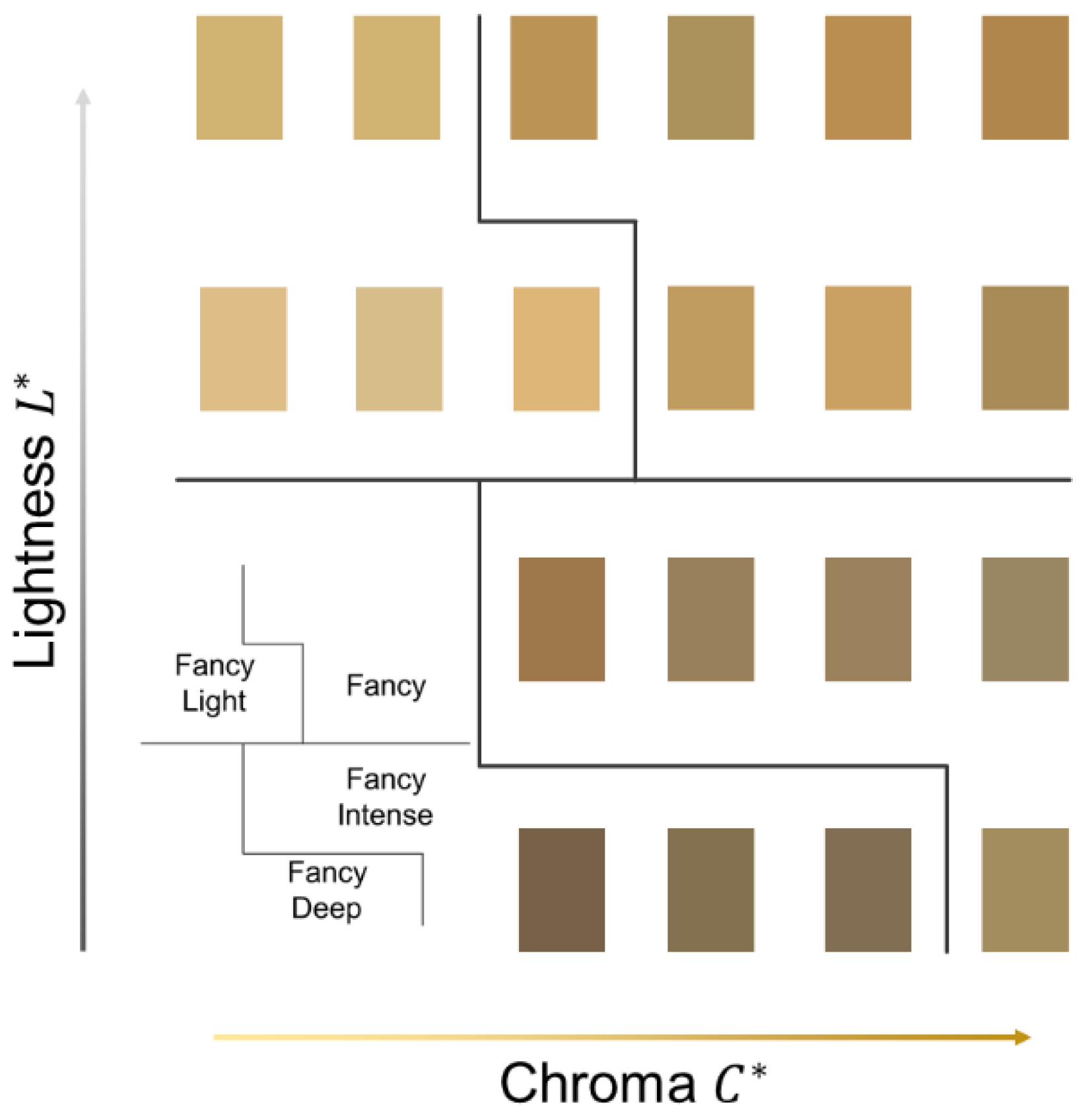
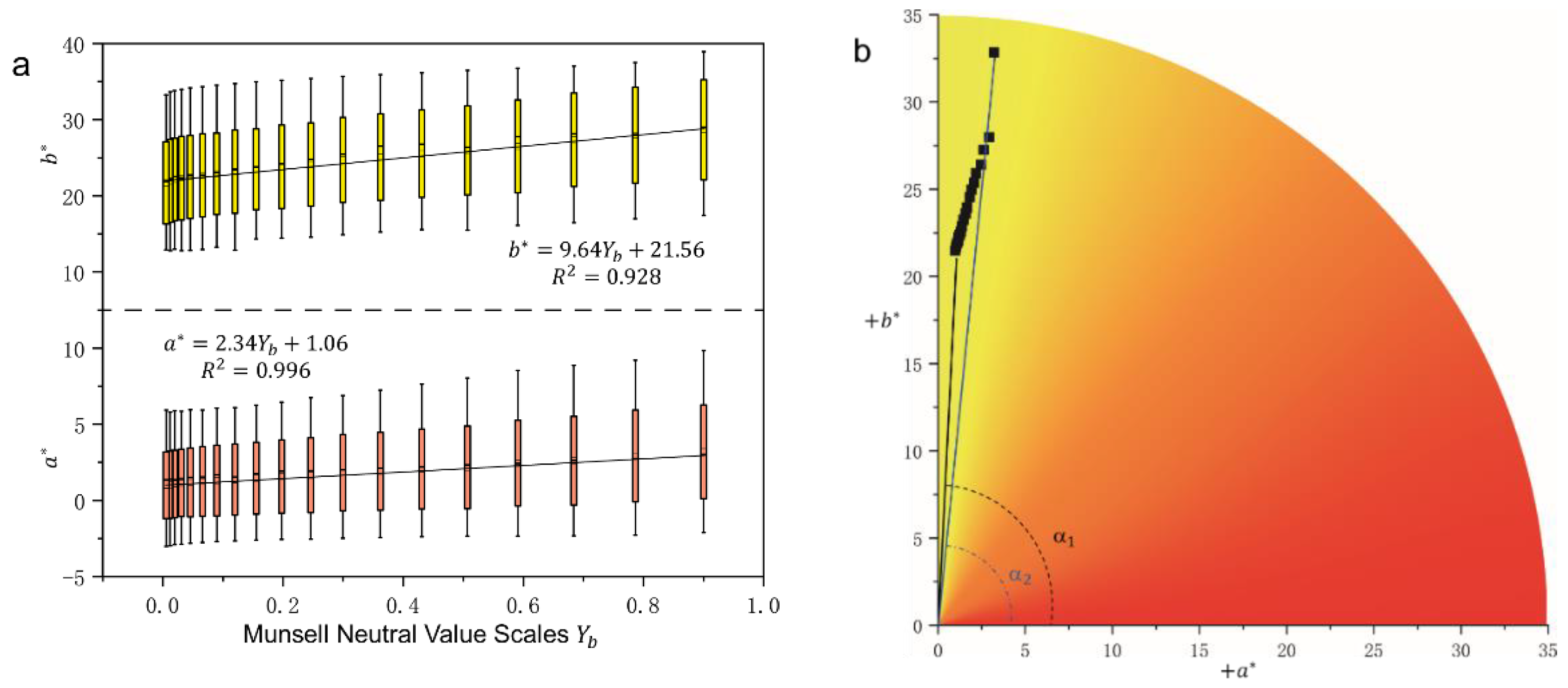
| Methods | Cluster Center | ||||
|---|---|---|---|---|---|
| 1 | 2 | 3 | 4 | ||
| AP | Coincidence Rate | 100% | 100% | 83.3% | 100% |
| Within the group | 3.79 | 3.47 | 3.01 | 3.12 | |
| 13.164 | 14.035 | 4.766 * | 4.623 ** | ||
| Y-Jade-415 | |||||
| Member | 12 | 5 | 6 | 10 | |
| 1 | 2 | 3 | 4 | ||
| K-means | Coincidence Rate | 100.0% | 100% | 100% | 75.0% |
| Within the group | 3.39 | 2.41 | 3.12 | 4.34 | |
| 4.941 ** | 24.579 | 15.38 | 7.28 * | ||
| Y-Jade-447 | |||||
| Y-Jade-454 | 5.57 ** | 25.678 | 16.449 | 8.1 * | |
| OY-Jade-425 | 15.589 | 13.389 | 5.55 ** | 6.849 * | |
| Member | 9 | 5 | 7 | 12 | |
Publisher’s Note: MDPI stays neutral with regard to jurisdictional claims in published maps and institutional affiliations. |
© 2022 by the authors. Licensee MDPI, Basel, Switzerland. This article is an open access article distributed under the terms and conditions of the Creative Commons Attribution (CC BY) license (https://creativecommons.org/licenses/by/4.0/).
Share and Cite
Liu, Z.; Guo, Y. The Effect of Munsell Neutral Value Scale on the Color of Yellow Jadeite and Comparison between AP and K-Means Clustering Color Grading Schemes. Crystals 2022, 12, 241. https://doi.org/10.3390/cryst12020241
Liu Z, Guo Y. The Effect of Munsell Neutral Value Scale on the Color of Yellow Jadeite and Comparison between AP and K-Means Clustering Color Grading Schemes. Crystals. 2022; 12(2):241. https://doi.org/10.3390/cryst12020241
Chicago/Turabian StyleLiu, Ziyuan, and Ying Guo. 2022. "The Effect of Munsell Neutral Value Scale on the Color of Yellow Jadeite and Comparison between AP and K-Means Clustering Color Grading Schemes" Crystals 12, no. 2: 241. https://doi.org/10.3390/cryst12020241
APA StyleLiu, Z., & Guo, Y. (2022). The Effect of Munsell Neutral Value Scale on the Color of Yellow Jadeite and Comparison between AP and K-Means Clustering Color Grading Schemes. Crystals, 12(2), 241. https://doi.org/10.3390/cryst12020241







